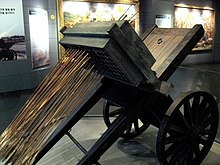Hwacha
A hwacha or hwach'a was an anti-personnel and black powder weapon that was developed and used in Korea in the 15th century . It consisted of a cart on which a launch pad for small missiles was mounted. Projectiles were mounted on the rockets , which when detonated scattered sharp pieces of iron. Together with the turtle ship , this technological achievement is said to have contributed significantly to Korea's victory over Japan in the Imjin War between 1592 and 1598, according to some historians .
history
The first hwacha was made by some Korean scientists during the Joseon Dynasty in 1409 , but it is believed that it was never used in combat. During the rule of Sejong , the production of the Hwachas increased and up to 90 pieces were used. At the end of his tenure, a Hwacha could take up to 200 missiles at the same time.
Stronger and significantly more effective versions of this artillery weapon were developed by 1451 and stationed in large numbers in Seoul and on the northern border.
Role during the Imjin War
During the Japanese invasion of Korea from 1592 to 1598, hwachas were used in large numbers against the soldiers of Japan . Most Hwachas were stationed in fortresses and served to defend against opposing troops, such as in the Battle of Haengju . The Japanese samurai then usually attacked in close formations, which were an ideal target for artillery.
The artillery weapon was also used on Admiral Yi Sun-sin's navy ships , such as the Panokseons in the Battle of Noryang Point .
construction
A hwacha consisted of a simple handcart on which a wooden launch pad was mounted, with between 100 and 200 holes for singijeon (ancient Korean missiles). The rockets consisted of arrows to which paper bags with black powder were attached and fired with a fuse. Up to 100 missiles could be fired at the same time and had a range of up to 500 meters.
Hwachas were mostly made of pine wood , and more rarely oak , the ropes used were hemp ropes . The weapons were packed and transported to the battlefield with a large escort. Similar to the European Bliden , the artillery weapon was only set up on the battlefield, the mount for the rockets was mounted on the cart , similar to Lego blocks .
Web links
Individual evidence
- ↑ Ki-Baik, Lee; Edward J. Schultz (September 2005). New History of Korea , 2nd Edition, Harvard University Press, 518 pages. ISBN 0-674-61576-X .

